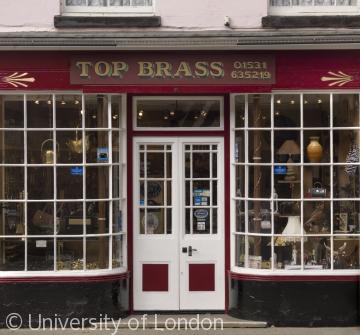Shops and Workshops
 An 18th-century shop front in Ledbury, Herefordshire
An 18th-century shop front in Ledbury, HerefordshireShops as we know them really began to develop in the later seventeenth century. According to the Oxford English Dictionary the word ‘shop’ as a verb, in the sense of to go to make a purchase, only came into use in the mid-eighteenth century (1764). Before that it was used to mean to expose goods for sale (1688) and, more commonly, a workshop.
In the middle ages goods were exposed for sale on boards let down onto the street from the windows of buildings which were usually both the workshop and the home of the craftsman. These balks or counters were permitted to extend as far as the ‘eaves-droppings’ – awnings supported on brackets, extending six or seven feet over the pavement. These were sometimes permanent fixtures, tiled over, and sometimes the space was jettied over in the 15th and 16th centuries. In many cases the area later became incorporated in the building, as the overhanging timber jetty was underbuilt in brick with windows, creating a new shop front.
Customers, attracted by the exposed wares, would enter the shop, part-workshop, part-storage area, to conclude the purchase. Gradually these rooms became more recognisably shops as we know them. Probate inventories and occasionally leases refer to the fittings of the shop, shelves and counters, weights and measures, as well as to the stock in trade. Developments in the making of glass towards the end of the 18th century permitted the insertion of bow-windows. Goods could be laid out enticingly in the window area and increased light in the interior also encouraged more elegant fittings inside, polished counters and gleaming cupboards. Shopping was about to become a leisure activity, for some at least. Similar technical advances in the production of glass continued through the 19th and 20th centuries and led eventually to the sheer plate glass fronts of the modern shopping mall.
By the early 19th century even modest market towns had a selection of shops, selling millinery and mercery, books and stationery, china and ironmongery and an increasing variety of foodstuffs. The coming of the railways greatly increased the availability of goods and fewer shopkeepers were directly involved in the production of the goods they sold. In larger towns and cities department stores began to appear and by the early 20th century a number of chain stores, including Boots the Chemists, were already spreading across the country.









